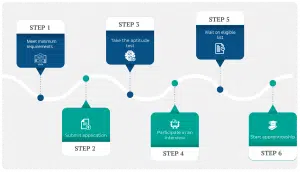The Foreign Service Officer Test (FSOT) is a screening test for people looking for a career in the foreign service. The different sections on the exam test your knowledge, judgment, and English skills.
The foreign service exam is the third step in the FSO selection process, and the first major hurdle you will need to overcome on your path to becoming a foreign service officer. You will be unable to move on in the process until you have passed the test.
You will take the FSOT test at a Pearson VUE test center on a computer. You’ll have about 3 hours to complete 125 multiple choice questions, navigate 28 multiple choice scenarios, and write one essay.
Did you know?
The FSO exam is divided into 4 sections covering a wide range of topics: (1) Job knowledge, (2) situational judgment, (3) English expression, and (4) English essay writing. If you score less than a 154 on the first three sections of the test, your essay will not be graded. To excel on this test you will need a wide range of knowledge, and be able to work quickly through the material.
FSOT Question Types Explained
The Foreign Service Officer Test is a multiple-choice test with an essay covering four different sections. You will have 3 hours to complete all the sections of the test. Occasionally, the FSO includes an extra 30 minutes of questions, which are not included in your score but are used for research purposes. You should be made aware of that before you go in for the test.
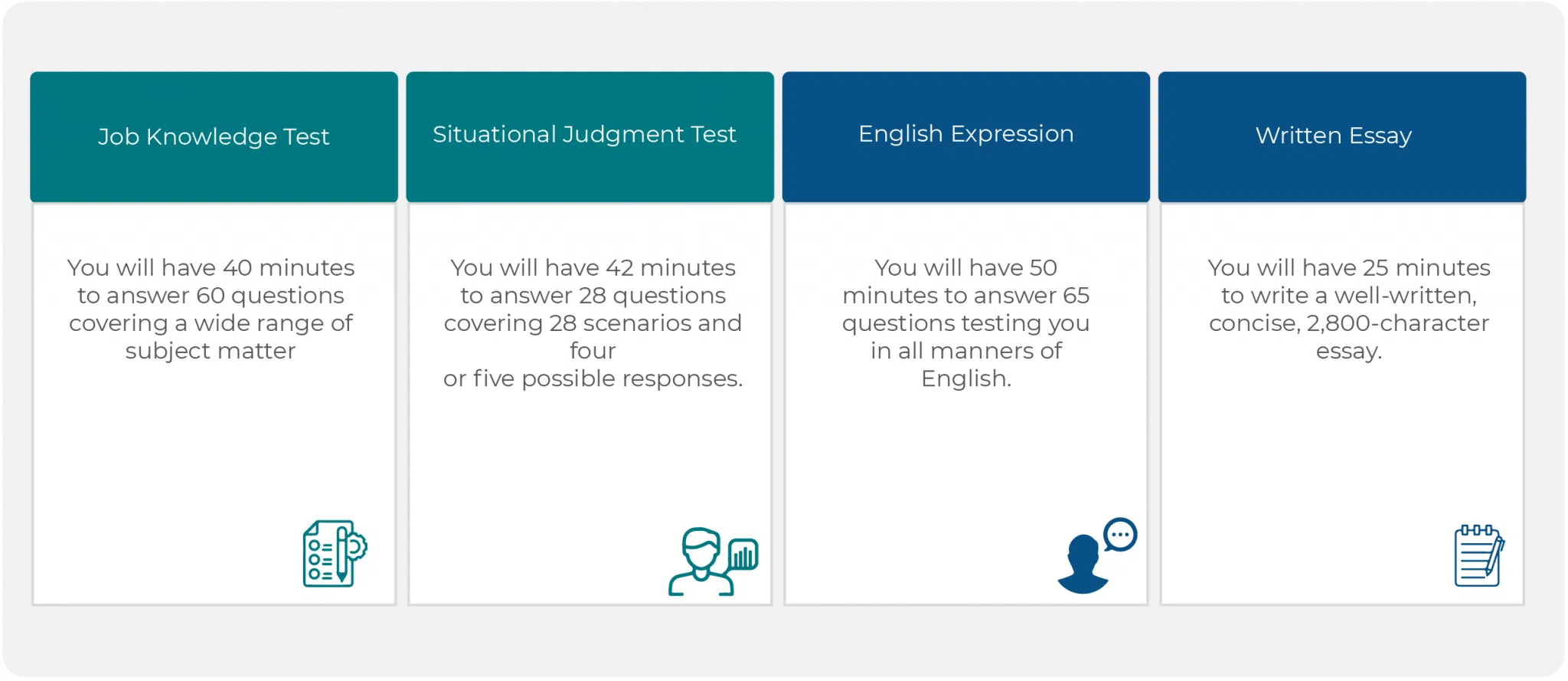
| Section | Number of Questions | Time Limit | Average Time Per Question |
|---|---|---|---|
| Job Knowledge | 60 | 40 minutes | 40 seconds |
| Situational Judgement | 28 | 42 minutes | 90 seconds |
| English Expression | 65 | 50 minutes | 46 seconds |
| Written Essay | 1 | 32 minutes |
Job Knowledge Test
The Job Knowledge test covers several major content areas and is equally important across all five foreign service tracks. You will have 40 minutes to answer 60 questions covering a wide range of subject matter.
Those subjects include:
- U.S. Government
- U.S. History, Society, Customs, and Culture
- World History and Geography
- Economics
- Math and Statistics
- Management Principles, Psychology, and Human Behavior
- Communication
- Computers and Internet
The following paragraphs provide additional detail on each of the subjects.
United States Government – general understanding of federal government, the constitution, Congress and its role in foreign affairs, the U.S. political system and its role in government policies
United States History, Society, Customs, and Culture – includes major events, institutions, history, politics, national customs and culture, social issues, trends, the influence of society on foreign policy
World History and Geography – includes world-historical events, issues, developments, and their impact on US foreign policy
Economics – understanding of basic economic principles and the economic system in the U.S.
Mathematics and Statistics – basic math and statistical procedures
Management Principles, Psychology, and Human Behavior – general understanding of human behavior, leadership, motivational strategies, and equal employment practices
Communications – know principles of effective communication, public speaking, media, and the goals and techniques of public diplomacy
Computers and Internet – basic knowledge of word processing, databases, spreadsheets, email, and internet use
All questions are multiple-choice, and you will have four options from which to choose.
Winning Tip
Your score is based on the number of correct answers you submit. If you don’t know an answer, you can always skip the question and come back to it after you’ve finished the questions you know, before you exit the section of the test.
Try a Job Knowledge Sample Question
Which Soviet Union leader did President George Bush meet at the Malta Summit of December 1989, in which the United States and the Soviet Union declared the Cold War over?
- Mikhail Gorbachev
- Leonid Brezhnev
- Vladimir Putin
- Boris Yeltsin
The correct answer is Mikhail Gorbachev.
The Malta Summit comprised a meeting between US President George H. W. Bush and Soviet General Secretary Mikhail Gorbachev, taking place on December 2–3, 1989, just a few weeks after the fall of the Berlin Wall. During the summit, Bush and Gorbachev would declare an end to the Cold War although whether it was truly such is a matter of debate.
Situational Judgment Test
The Situational Judgment section presents you with 28 scenarios and four or five possible responses. You are asked to identify both the best and worst possible responses among the choices given. The scenarios cover adaptability, decision-making, judgment, operational effectiveness, professional standards, team building, and workplace perceptiveness.
You don’t need to know State Department policies or procedures to answer these questions.
Winning Tip
Take your time to read through the scenario and response options carefully. You are being asked to identify two things in these questions, but you also have a minute-and-a-half for each scenario, so use the time fully.
Try a Situational Judgment Sample Question
A clerk in your unit performs work quickly but carelessly. This clerk is about to transfer to another unit. The head of that unit asks you for your opinion of the employee’s work.
What would be the BEST course of action to handle this situation?
- Emphasize the employee’s good points and downplay the bad.
- Allow the employee to begin with a clean record by avoiding any criticism.
- State that the employee works quickly but carelessly.
- Warn the unit head that he or she would be making a big mistake by hiring the employee.
The best answer is C. Stating the truth, is the best answer to this question. People have trouble with some supervisory questions is because they may answer a question based on experiences they have seen or participated in. On your upcoming test, that is not always a good idea, as you might miss a question like this for that reason. Option A is a very common answer, and incorrect. Of course, people do this all the time in real life to be nice, or because they want to unload someone. However, it is not considered good supervisory practice. While it may help your unit, it won’t help the other unit, the organization, or the individual involved. Option B is incorrect for the same reason. Option D is incorrect because it is going to the other extreme, and that would also not be fair to the employee.
English Expression
The English Expression portion of the test gives you 65 questions testing you in all manners of English. You will be asked to select correctly written sentences, make corrections in sentences using the options provided, and organize or revise paragraphs.
All questions are multiple-choice and have 4 options for each question.
Winning Tip
Familiarize yourself with the types of questions you will see on the test, so you don’t waste a lot of time trying to understand what is being asked of you.
Try an English Expression Sample Question
Select the one underlined word or phrase that needs to be changed to make the sentence correct, or indicate that none of the underlined parts are in error.
Some people believe that public health should be improved by increasing the amount of sports facilities, while others believe that it has little effect and other measures should be taken to solve this problem.
- NO ERROR
- should be improved
- amount of sports facilities
- has little effect
The problem is found in “amount of sports facilities”.
Number refers to items we can count. Amount refers to quantities we can measure but not individually count.
Sports facilities are countable so the correct term to use would the “number of sports facilities” rather than the amount of them.
Written Essay
You will be presented with 3 topics for the essay, and have 7 minutes to choose the topic you want to write about. Once selected, you will have 25 minutes to write a well-written, concise, 2,800-character essay (roughly 400-700 words) that takes a position on your topic and develops a rationale for that opinion.
You will be scored on your ability to analyze a topic and the quality of your writing. You are not evaluated based on your opinion.
Winning Tip
Practice writing essays before the test to give yourself a better sense of 2,800 characters. That will enable you to visualize the essay and plan the length of your arguments.
Sample Essay Question
Passage:
As more employers explore flexible work arrangements, some argue that allowing employees to adjust their schedules or work remotely improves overall job satisfaction, reduces stress, and enhances productivity. Others caution that too much flexibility blurs the boundary between personal and professional life, potentially reducing efficiency and accountability.
Assignment:
Should workplaces place greater emphasis on providing flexibility and work-life balance, or should they maintain traditional work structures and expectations? Plan and write a multi-paragraph 2,800-character essay in which you develop your point of view on the above question. Support your position with reasoning and examples taken from your reading, studies, experience, or observations.
Partial Essay (Introduction Only):
In today’s educational landscape, there is a growing debate about whether schools should increase their use of digital technology in the classroom or return to more traditional learning methods. Technology enthusiasts argue that digital tools can broaden access to information, enhance interactive learning, and prepare students for a tech-centric workforce. Skeptics, however, worry that too much screen time undermines students’ ability to focus, think critically, and engage meaningfully with their studies. While it is essential to recognize the value of both perspectives, I believe that, when used judiciously, increasing the use of digital technology can help schools create more dynamic and effective learning environments.
Feedback on the Provided Portions (Note: Essay is Incomplete)
Overall Score Estimate for these Portions: The introduction and first argument paragraph, if evaluated on their own, would likely achieve a strong mid-to-high range score. The writing is organized, clear, and reasonably well-developed for the introduction and first supporting point.
Strengths:
- Clarity of Position: The introduction clearly lays out the debate and states a position in favor of judiciously using more digital technology.
- Focus and Organization: The introduction sets a context, mentions both sides of the issue, and smoothly transitions into the stance. The first argument paragraph then logically supports this stance with relevant details.
- Use of Reasoning and Examples: The first argument paragraph effectively explains how digital resources can enhance learning by providing a variety of materials and enabling differentiated instruction.
Areas for Improvement:
- Depth of Explanation: While the first argument is clear, it could benefit from more concrete examples or brief anecdotes to strengthen its impact.
- Complexity of Language: The writing is clear and correct, but it could use slightly more varied vocabulary or sentence structure to further engage the reader.
FSOT Preparation Strategies
While there are sections within the foreign service officer exam that are difficult to study for, you can prepare for many of the components within the test. While we normally recommend buying a book to study from, the FSO is different. Most of the available books are out of date and don’t cover the situational judgment test. Look to online sources, including iPrep’s course, which tend to be updated more frequently and should serve you well.
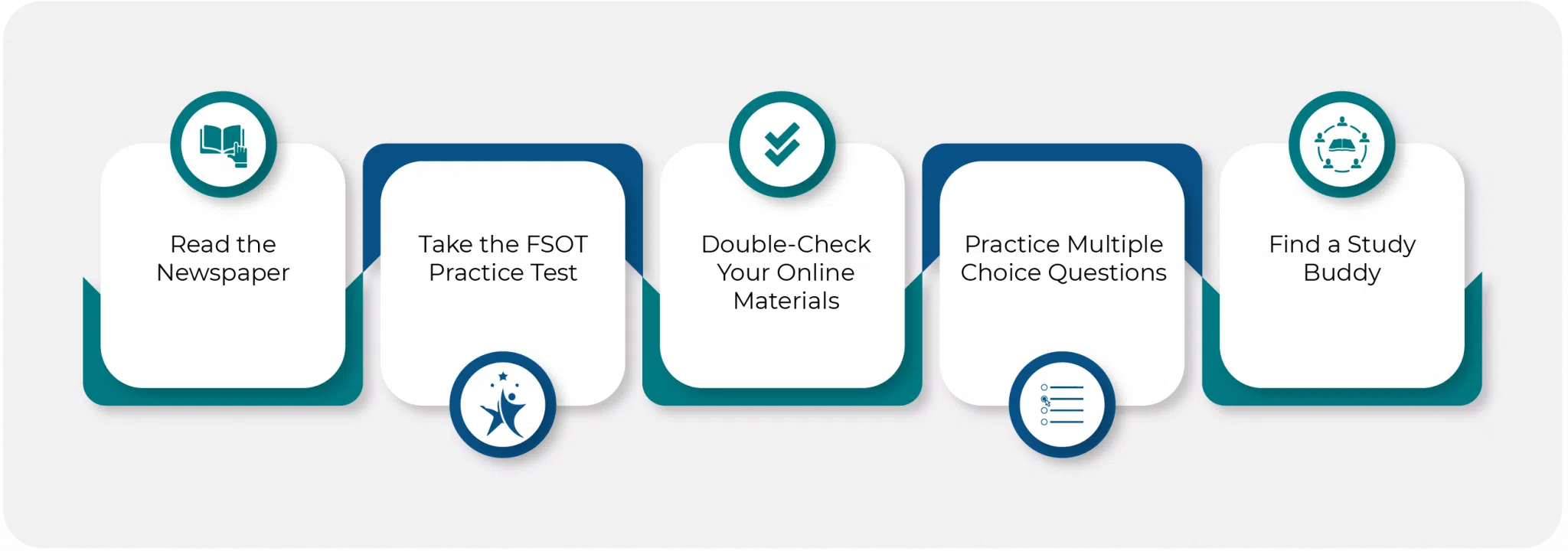
1. Read the Newspaper
Start by reading major newspapers, like the New York Times, the Wall Street Journal, and The Washington Post. Make sure to read foreign papers as well, such as The Guardian and The Daily Mail. Don’t ignore online publications like The Times of India or China Daily, which give insight into a number of areas.
2. Take the FSOT Practice Test
The official foreign service exam practice test will simulate conditions and give you a realistic preview of what to expect, as well as offer you study materials that will help you pass. However, you can only take the practice test once every six months, and the practice FSOT test does not include the essay.
It behooves you to enroll in online study courses with test simulators, like the one offered by iPrep, which will help you mark progress as you prepare for the test.
3. Double-Check Your Online Materials
The FSOT has changed over the years, and many online sources will prepare you for a test that has changed. Be sure that the test prep site you are looking at is aware of the changes, and the description of its materials is aligned with the current FSOT exam.
4. Practice Multiple Choice Questions
Multiple-choice questions are a skill, and learning to answer them quickly can make the difference between finishing within the allotted time and reading through question 34 when the time is up.
Take a course that shows how to quickly eliminate options, and make educated guesses.
5. Find a Study Buddy
Work with a friend or someone you find online to study together. Try to find someone who can help fill in general knowledge areas where you may be weaker. You’ll also be able to discuss situational judgment scenarios and talk through the notions that are being assessed.
Test Features
Test Fast Facts (tl;dr)
- Total of 153 questions and scenarios
- The test takes about 3 hours to complete
- There are 4 sections
- Job Knowledge – includes politics, current events, history, geography, math, and more
- Situational Judgment – asks you to identify reactions to scenarios
- English Expressions – covers a range of English questions
- Written Essay – asks you to write a 2,800-character essay on a topic
- The test is administered three times a year: February, June, and October
- You may not use calculators or mobile devices during the test
- The test costs $5
- If you miss the test or fail to cancel at least 48 hours in advance you will be charged $72
- The test is administered at Pearson VUE testing centers
- You must show a current government or state-issued ID
- For security purposes, your picture will be taken at the test center
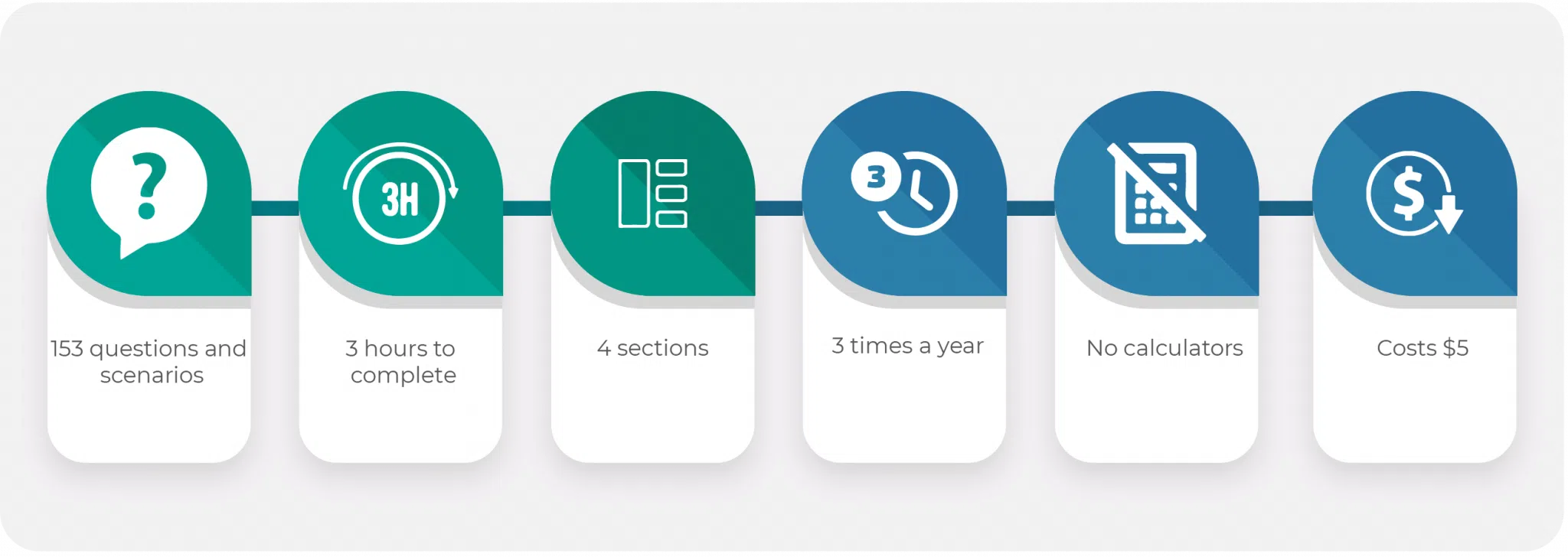
Common Names of the Test
While the official name of the test is the Foreign Service Officer Test, the test has many unofficial names, including:
- FSOT
- Foreign Service Exam
- Foreign Service Officer Test
- FSOT Written Exam
- FSO Test
- FSO Exam
- Foreign Service Officer Exam
- Foreign Service Test
- FSOT Exam
- US Foreign Service Exam
- Foreign Officer Test
- Pearson VUE FSOT
All these names refer to the same test.
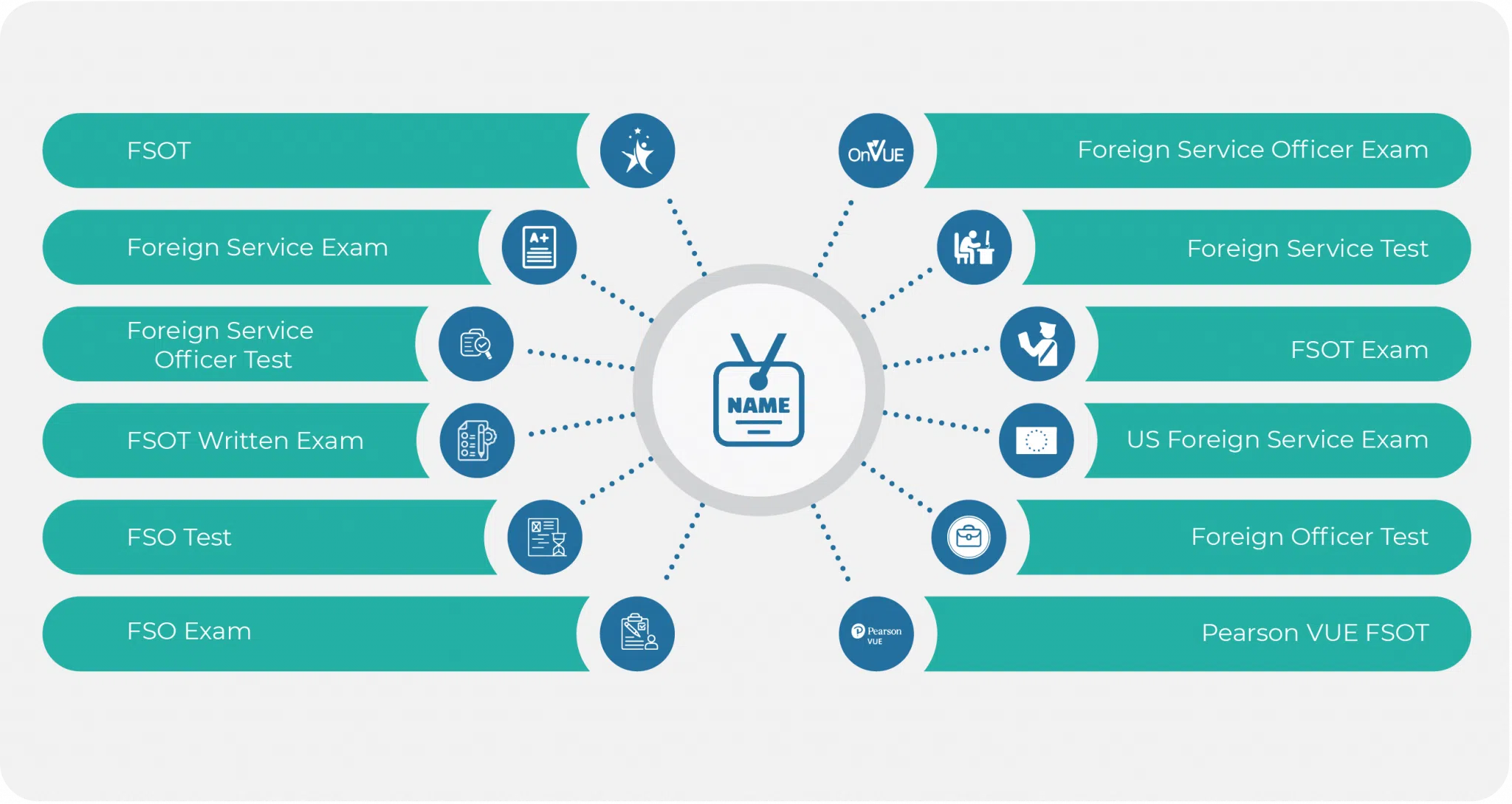
Retake Policy
If you do not pass the test, you may retake it once every 12 months, as many times as you like. If you do pass the test but are not selected as an FSO, you will need to retake the test to be considered for the position again.
Fees
There is a $5 fee to take the test. However, if you miss the test or do not cancel at least 48 hours in advance, you will be assessed a $72 fee. You will be unable to sign up for future tests unless you pay the fee.
Technical Facts
The FSOT is given as a screening test for candidates interested in becoming a member of the foreign service. To apply, you must meet the following criteria:
- U.S. citizen
- Aged 20-59 on the day you submit FSOT registration
- Aged 21-59 on the day you are appointed as a Foreign Service Officer
- Available for worldwide assignments, including Washington D.C.
FSO Selection Process
The selection process for becoming a Foreign Service Officer is quite lengthy. There are 8 steps that you must complete to become an FSO.
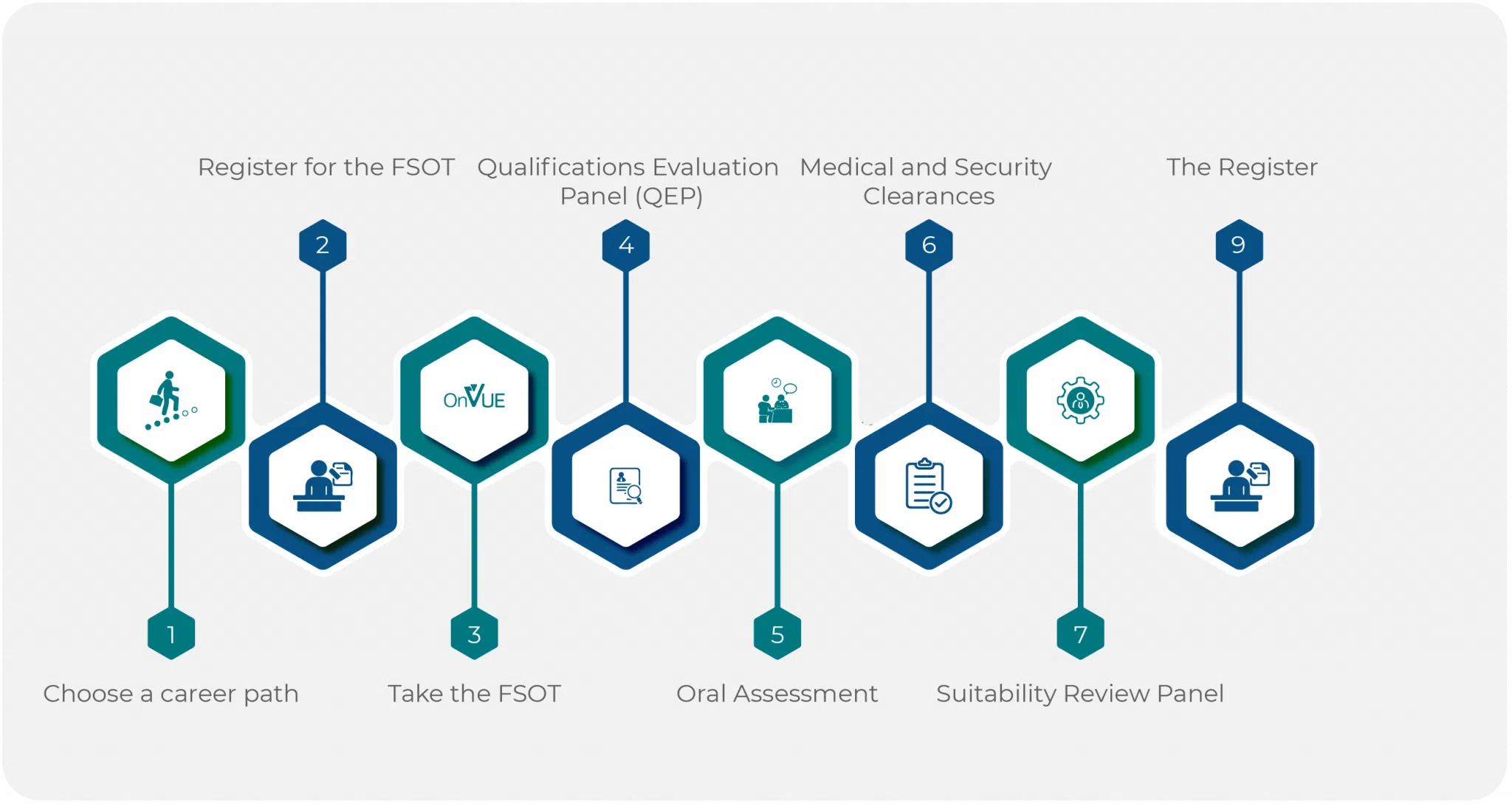
Step 1: Choose a career path
There are many different careers within the foreign service. They fall into five categories:
- Consular
- Economic
- Management
- Political
- Public Diplomacy
You must declare your career track before taking the Foreign Service exam.
Step 2: Register for the FSOT
You may register for the exam at Pearson VUE five weeks before the testing window. You will need to create an account with Pearson VUE, and submit the following materials:
- Eligibility verification forms
- Application forms
- 6 complete personal narratives
You will select a test location and seat for your test date.
FSOT registration closes three days before the exam or when all available seats are filled.
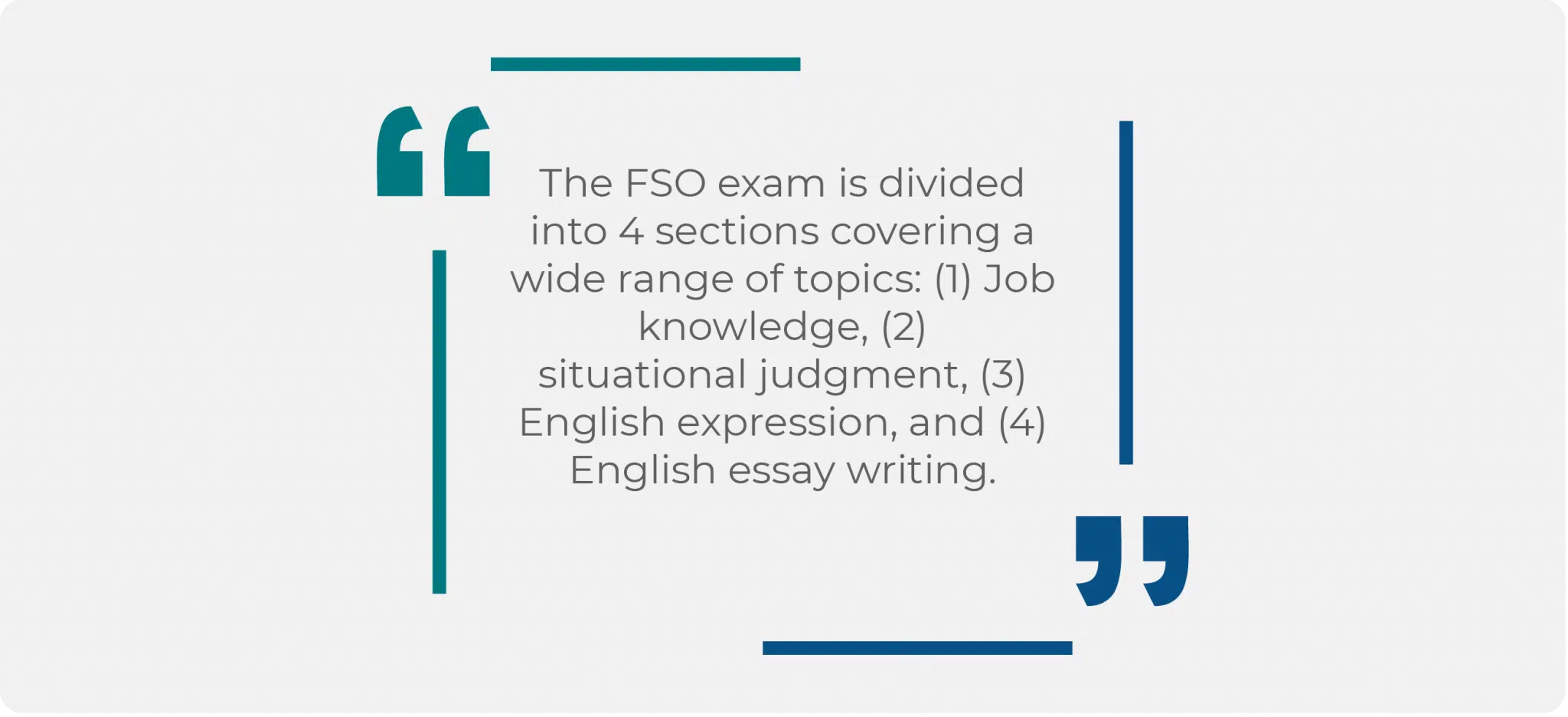
Step 3: Take the FSOT
You’ll be sitting in front of a computer for several hours. You will not be in contact with any Foreign Service Officers during the test, so dress comfortably.
Step 4: Qualifications Evaluation Panel (QEP)
If you pass the FSOT test, the QEP will review your written essay and read through your personal narratives. Successful candidates will then be invited to the Oral Assessment.
While test scores figure prominently in this process, you may successfully complete all stages to this point and not be invited to the next stage if there aren’t available positions. If that happens, you will be required to repeat the selection process.
QEP results are available approximately two months after completing the FSOT.
Step 5: Foreign Service Oral Assessment (FSOA)
The Foreign Service Officer Assessment (FSOA) is a key step in the Foreign Service Officer selection process. It is offered in Washington, D.C., and will soon be available virtually in the U.S. and overseas. The FSOA evaluates various skills critical to the role of an FSO and includes exercises that simulate real-world diplomatic scenarios.
The Foreign Service Oral Assessment (FSOA) includes three components:
- Case Management Exercise: Candidates are given a hypothetical scenario where they must analyze information, prioritize actions, and propose solutions. This exercise tests analytical and decision-making skills.
- Group Exercise: In this segment, candidates work collaboratively to reach a consensus on a given issue. It assesses teamwork, diplomacy, and negotiation abilities, crucial for a career in the Foreign Service.
- Structured Interview: This part involves a personal interview focusing on the candidate’s experiences and qualifications, evaluating their suitability for a Foreign Service career.
This comprehensive, full-day evaluation is designed to assess candidates’ proficiency in the key dimensions critical to the role of an FSO. These dimensions are:
- Composure
- Cultural adaptability
- Experience and motivation
- Initiative and leadership
- Judgment
- Objectivity and integrity
- Oral communication
- Planning and organizing
- Quantitative analysis
- Resourcefulness
- Working with others
- Written communication
Applicants should approach this as a professional job interview: dressing formally, arriving punctually and being thoroughly prepared.
After passing the oral assessment, you will receive a conditional job offering subject to subsequent clearances as described below.
Step 6: Medical and Security Clearances
You will receive instructions on how to apply for the clearances that are required.
Step 7: Suitability Review Panel
A panel will review your entire file, and determine whether you are suited for a career in the Foreign Service. The panel takes past behaviors into consideration, including criminal conduct and behavior at prior workplaces.
Step 8: The Register
Once you have passed all steps, your name is placed on the register, listed by successful candidates. Your name will remain on the register for up to 18 months. During that time, if an appropriate opportunity comes up, you may be offered an appointment.
Results Scale and Interpretations
Your FSOT results are available about 3 weeks after taking the test. Your raw scores are normalized into percentiles that compare your scores to every other candidate within your testing period.
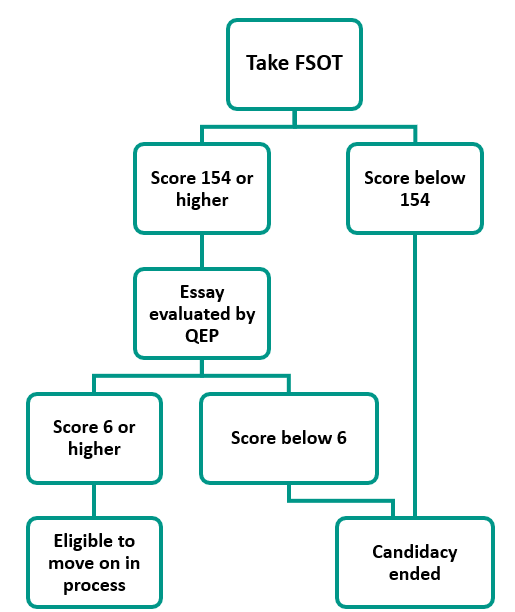
The precise algorithm has not been disclosed by Pearson VUE. However, you must score a 154 or higher on the test. Anything below that score is considered failing and you will not move on in the process.
- A score of just over 50 in each section is considered a passing score
- Scores that are above 60 in each section are considered to be good scores
- Scores that are above 70 are considered to be an amazing score
- Scores above 80 are rare, and 99.9% of all test takers score below 80
Higher scores will often enable you to move forward in the process, and get through the QEP phase.
If you score 154 or higher, the QEP will evaluate your essay. The essay is worth up to 12 points, with 6 being a passing score. Scores are rarely higher than 8. If you score below a 6, your candidacy will be eliminated regardless of how high you scored on the other sections of the test.
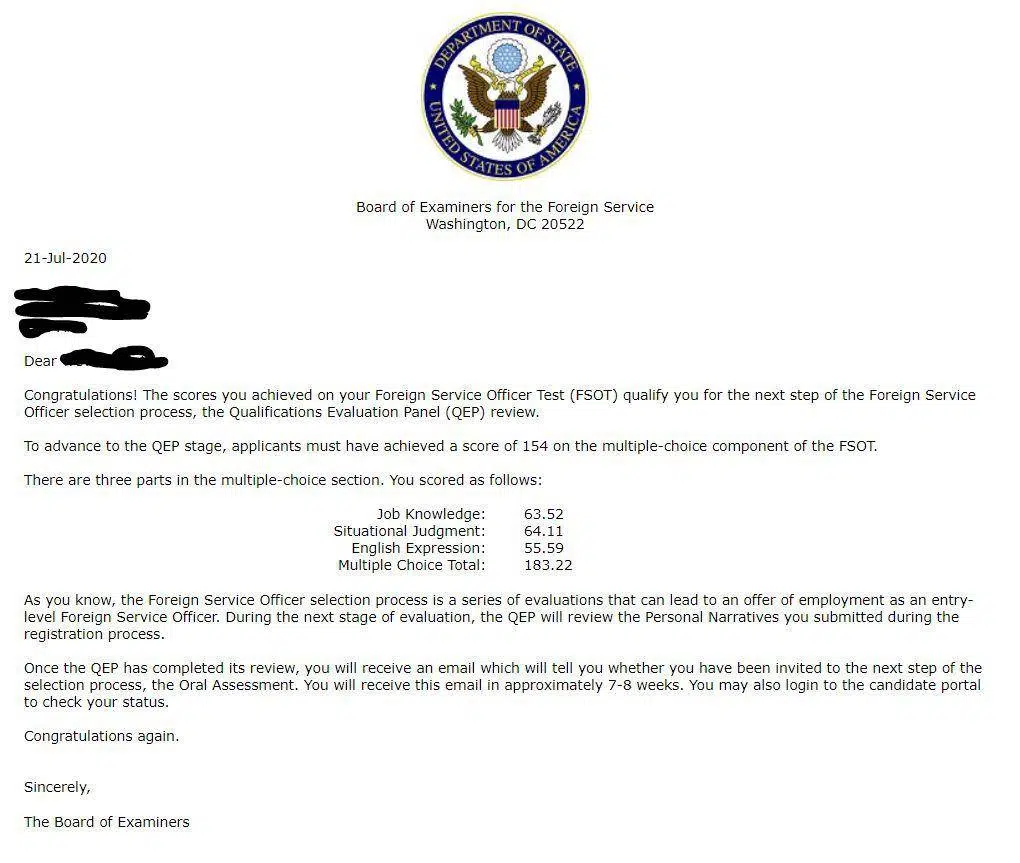
NOTES
- Your FSOT score is valid only for the time period during which you were tested. If you scored well but did not submit your personal narratives, your candidacy will not be considered and you must wait 12 months to take the test again.
- There is no penalty for wrong answers in the Job Knowledge and English Expression sessions, so if you are stuck, you are better off guessing.
Wrong answers will reduce your score in the Situational Judgment section. If you are completely unsure, you will be better off leaving an answer blank.
FSOT FAQs
The Foreign Service Exam is an informal name of the Foreign Service Officer Test (FSOT). It is a screening test used by the Foreign Service to identify candidates for roles within its organization.
The Foreign Service Officers Test is a multiple-choice test that covers a broad spectrum of topics including the U.S. Government, history, economics, math, and English. It also includes scenarios where you are asked to choose the best and worst reactions from a series of choices.
To prepare, you’ll want to take simulated practice FSOT tests, like those offered by iPrep, to familiarize yourself with the test format and types of questions. You can also study using online test prep courses.
There isn’t an exact pass/fail score, but generally speaking, a score of 154 or higher will be enough to have your personal narratives and essay evaluated by the QEP.
There are 153 questions and scenarios on the FSOT, plus one essay.
The FSOT is a challenging test, with questions covering a wide array of content. However, with most of the questions, you either know the answer or you don’t. You won’t need to do many calculations to arrive at an answer.
The FSOT tests your knowledge of America and the world. It examines the judgments you make and tests your English and writing skills.
Foreign officers must be U.S. citizens aged 21 and up. New employees must be younger than 60.
The Foreign Service has a clearly designed process to join. You will need to write personal narratives, pass a test, spend a day on oral examinations, and then pass a final review. Once you have successfully completed that process, your opportunities will depend on whether there are available jobs for you.
If you pass the FSOT, your essay and personal narratives are reviewed by the QEP. If you pass their review, you will be invited to the oral examination.
You can retake the FSOT once every 12 months for as many years as you want.
A score of 154 or higher is considered to be a good score on the FSOT.
Your FSOT is one of the criteria used by the Foreign Service in determining whether you will be successful there. If you fail the FSOT, you will not be able to join the Foreign Service.
The FSOT covers a large amount of content. You should make an effort to study the following subjects:
– English Composition/Rhetoric
– American History
– American Studies (including cultural and social history)
– American Political Thought
– United States Political System
– American Economic History
– Introduction to Economics (micro and macro)
– World History (Western and non-Western)
– World Geography
– International Economics
– World Religions
– Introduction to Statistics
– Introduction to Management Principles
– Intercultural Communication
– Mass Communication
– Psychology
The FSOT costs $5 to take the test. However, if you miss your test or cancel within 48 hours of the exam, you will be assessed a $72 fee.
You can take the test once every 12 months, for as many years as you need to.
FSOT Test Tips
Here are some tips to help get you through test day.
1. Answer the questions you know first
While you can’t jump from one section to the next, you can skip questions within a section and then come back to the questions you skipped. Since all questions are worth the same number of points, and the test doesn’t get progressively more difficult, it makes sense to answer the items you know right away.
2. When in doubt, eliminate and guess
There are no penalties for wrong answers in the Job Knowledge and English Expressions sections, so if you are unsure about an answer, do your best to eliminate some of the options. If you can eliminate two obviously wrong answers, the odds of guessing right increases by 50%. Wrong answers in the situational judgment sections can hurt your score, so if you are going to guess, only do so if you have eliminated several of the options. If you are completely unsure, you will be best off leaving the item unanswered.
3. Read the directions carefully
Make sure to understand what is being asked of you before submitting your answer. Skimming over keywords might cost you the right answer.
4. Practice writing 2,800-character essays
Write some essays that meet the length requirement. You may be surprised at how much—or how little—2,800 characters can be.
5. Be aware of the time
Don’t spend too much time on any one question. For many of the sections you have less than a minute to answer so do your best, and either answer the question or skip it for later.
6. Stay calm and be well-rested
Taking care of yourself before the test will help you perform your best on test day. Get a good night’s sleep beforehand, eat a healthy meal, and keep your brain feeling clear and ready.
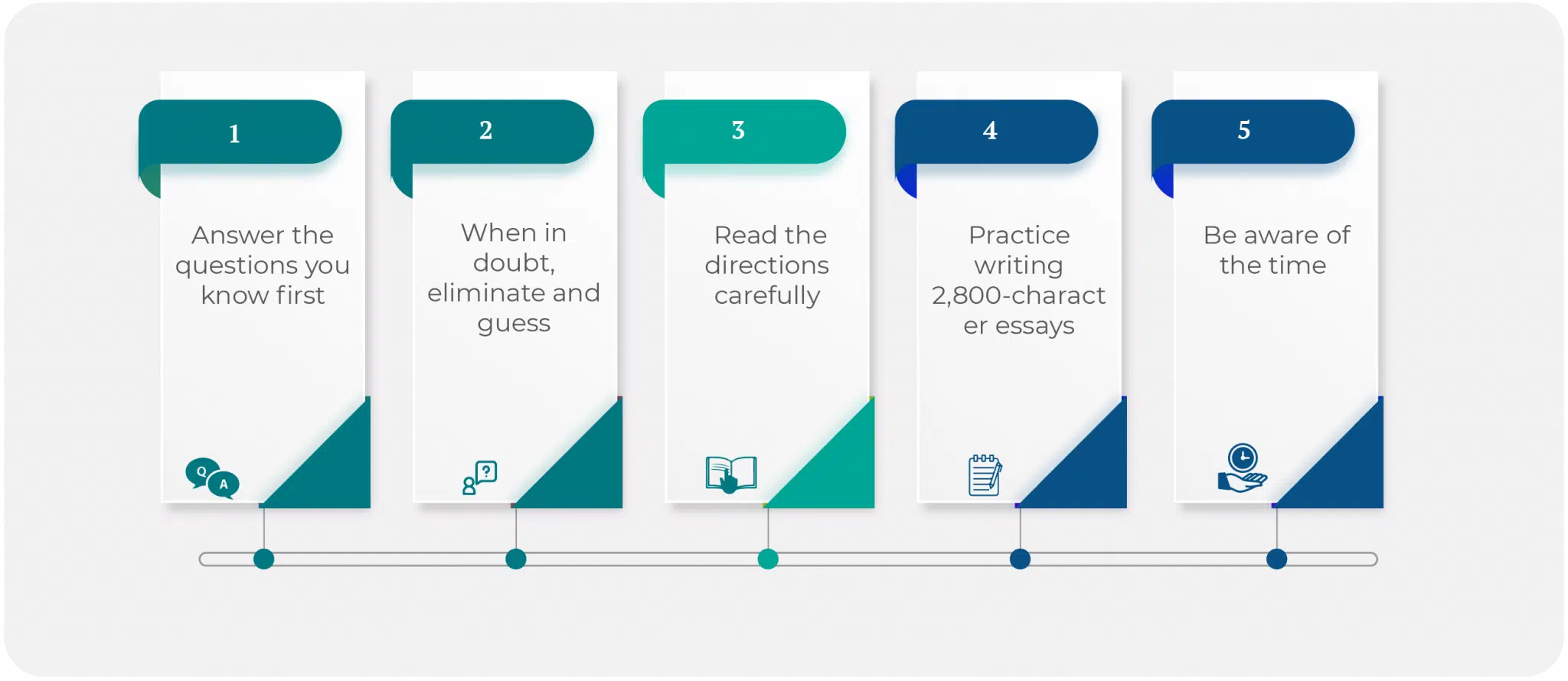
Administration
- Test Location: Tests are given at Pearson VUE testing centers
- Test Schedule: There are three test windows during the year, each of which lasts for one week. Tests are administered in February, June, and October. FSOT registration opens 5 weeks before the test dates and closes when all seats are taken or 3 days before the exam.
- Test Format: Multiple-choice, taken on a computer.
- Test Materials: Taken on a computer. You may not use any outside materials.
- Cost: The fee for the test is $5. If you miss the test or cancel within 48 hours, you will be assessed a $72 fee, which must be paid before you can reschedule the test.
- Retake Policy: You may take the test every 12 months.
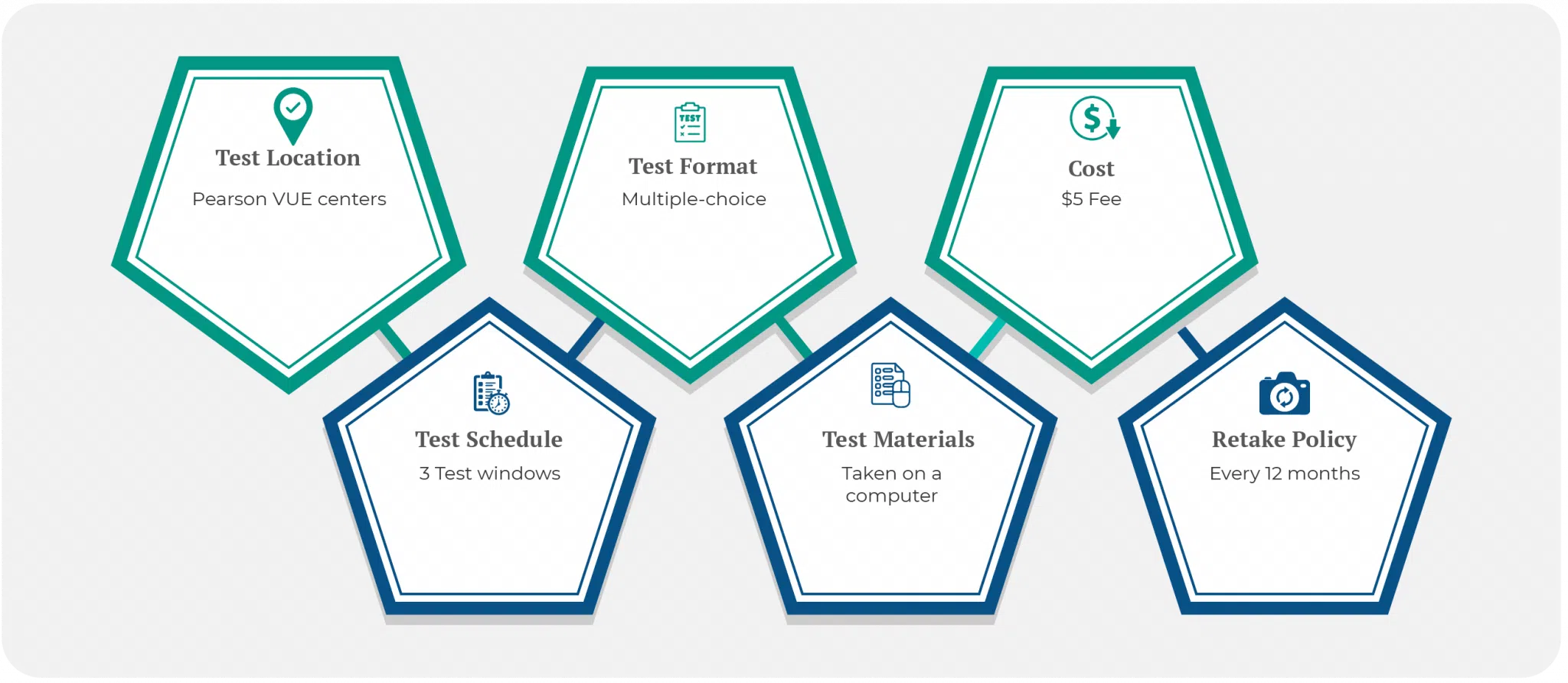
Test Provider
The FSOT test is administered by the Pearson VUE on behalf of the Foreign Service and the Department of State.
The test is designed to provide the Foreign Services Office with unbiased information regarding the likelihood of a candidate succeeding in the Foreign Service.
Information Sources
Disclaimer – All the information and prep materials on iPrep are genuine and were created for tutoring purposes. iPrep is not affiliated with the Foreign Service, Department of State, Pearson VUE testing centers, or any other company mentioned.
Free FSOT practice test: Get to know what the FSOT will be like by practicing with these sample questions:
Question 1 of 10
The EEOC is not responsible for protecting applicants from employment discrimination, based on their
- national origin
- religion
- mental health condition
- marital status
The correct answer is marital status.
Under the laws enforced by Equal Employment Opportunity Commission (EEOC), it is illegal to discriminate against someone (applicant or employee) because of that person’s race, color, religion, sex (including gender identity, sexual orientation, and pregnancy), national origin, age (40 or older), disability (physical or mental condition) or genetic information.
Only about half of the US states protect by state law against discrimination based on marital status. Federal employees are also protected from marital status discrimination by the Civil Service Reform Act of 1978 (CSRA).
Question 2 of 10
Which of the following is not an organized, unincorporated territory of the United States?
- Guam
- Northern Mariana Islands
- Marshall Islands
- Puerto Rico
The correct answer is the Marshall Islands.
Territories of the United States are sub-national administrative divisions overseen by the United States government. Five territories (American Samoa, Guam, the Northern Mariana Islands, Puerto Rico and the U.S. Virgin Islands) are permanently inhabited, organized, unincorporated territories. U.S. territories are under U.S. sovereignty and, consequently, may be treated as part of the United States proper in some ways and not others. Residents of U.S. territories cannot vote for the President of the United States, and they do not have full representation in the U.S. Congress.
The Marshall Islands is an independent island country. In 1944, during World War II, the United States took control of the islands. The U.S. government formed the Congress of Micronesia in 1965, a plan for increased self-governance of Pacific islands. Full sovereignty was achieved in 1979, after the islands’ constitution and president were formally recognized by the US.
Question 3 of 10
The deputy director of your agency recently made an erroneous statement in a presentation at a business conference. This comment might lead some attendees to make errors that would be costly for their businesses.
What would be the BEST course of action to handle this situation?
- Post a correction on the agency’s website.
- Send a correction to all attendees.
- Tell agency staff to be prepared to answer questions about the topic.
- Correct the error the next time the deputy director makes a public presentation.
The best answer is B.
The erroneous statement made by the deputy director might have serious consequences. Specifically, it “might lead some attendees to make errors that would be costly for their businesses.” Given the seriousness of the situation, the agency has a responsibility to send a correction to all attendees (Option B). The complete breakdown of the answer is provided after the next question. Option A, posting a correction on the agency’s website, might only be seen in time by a fraction of the attendees at the meeting, or perhaps not by any of them. Option C, telling agency staff to be prepared to answer questions, is also an unreliable option; it would probably deliver the information primarily to attendees calling in after the fact who had already made the mistake. Option D is wrong because it does not say how soon the deputy director’s next presentation will be and because there’s no way to be sure all the same people will be in attendance.
Question 4 of 10
The deputy director of your agency recently made an erroneous statement in a presentation at a business conference. This comment might lead some attendees to make errors that would be costly for their businesses.
What would be the WORST course of action to handle this situation?
- Post a correction on the agency’s website.
- Send a correction to all attendees.
- Tell agency staff to be prepared to answer questions about the topic.
- Correct the error the next time the deputy director makes a public presentation.
The worst answer is D.
The erroneous statement made by the deputy director might have serious consequences. Specifically, it “might lead some attendees to make errors that would be costly for their businesses.” Option D is the worst course of action because it neither guarantees a timely response nor it guarantees that the audience in the previous presentation will be exposed to it. Option A, posting a correction on the agency’s website, might only be seen in time by a fraction of the attendees at the meeting, or perhaps not by any of them. It is better than option D because it may reach a greater audience. Option C, telling agency staff to be prepared to answer questions, is also an unreliable option; it would probably deliver the information primarily to attendees calling in after the fact who had already made the mistake but at least it makes sure that there can be some damage control.
Question 5 of 10
Select the one sentence (of the four listed) that best meets the requirements of standard written English.
- Many people use spray sunscreen to protect their skin from the sun’s rays, and it’s a quick and easy way to apply sunscreen.
- Many people use spray sunscreen to protect their skin from the sun’s rays, but it’s a quick and easy way to apply sunscreen.
- Many people use spray sunscreen to protect their skin from the sun’s rays because it’s a quick and easy way to apply sunscreen.
- Many people use spray sunscreen to protect their skin from the sun’s rays; therefore, it’s a quick and easy way to apply sunscreen.
The correct answer is C.
This sentence uses the correct conjunction, which indicates causality.
Answer A is incorrect because the word and means another thing and not causality.
Answers B and D are incorrect because the words but and therefore express an opposite idea and not causality.
Question 6 of 10
Select one underlined word or phrase that needs to be changed to make the sentence correct, or indicate that none of the underlined parts are in error.
Online forums are a place where we can get answers to our questions and calm our doubts where we can connect with other like individuals and grow virtual friendships.
- NO ERROR
- a place where
- doubts where we
- grow virtual
The correct answer is C.
This is a run-on sentence where one idea runs into the other. To correct this you can either add a conjunction such as “and” or add punctuation such as a period or semicolon.
Question 7 of 10
Select the one word or phrase that needs to be used in place of the underlined text to make the sentence correct, or indicate that the underlined text is not in error.
At Fire Island, a popular tourist spot east of the city, the remains of what might have been the shipping vessel were uncovered.
- NO ERROR
- has been
- had been
- having been
The correct answer is A.
Explanation: The word “might” is an auxiliary verb. Therefore, because of the addition of “might,” the only possible answer is “have been.”
Question 8 of 10
Put the following sentences into the correct order to create a logical and flowing paragraph.
Sentence 1. With an ever-increasing population, clean water is becoming even more essential in developing African countries and it is estimated that investments of over $800 billion will be needed in the next few years.
Sentence 2. Drink 2025 is an initiative which aims to unite 7 drought-affected African nations in order to conserve water supplies and provide citizens with an uninterrupted supply of drinkable water.
Sentence 3. The initiative will bring together water conservation experts from around the globe, government agencies, charities, multilateral organizations, and private companies in order to raise the needed capital.
Sentence 4. The investment will ensure Africa remains healthy and disease free for many years to come.
- 1, 2, 3, 4
- 1, 3, 4, 2
- 2, 4, 1, 3
- 4, 3, 1, 2
The correct answer is A.
Explanation:
The logical flow of the paragraph is as follows.
Introduce the problem > Introduce the solution > Talk about the aims of the solution > Conclusion
Note the vocabulary connections in each sentence too.
“Developing African countries” in the 1st paragraph pairs with “7 drought-affected African nations” in the 2nd.
“Drink 2025” in the 2nd pairs with “the initiative” in the 3rd.
“Needed capital” in the 3rd pairs with “investment” in the 4th.
When tackling this type of question, you must take these vocabulary connections into account.
Question 9 of 10
The following sentences compose a paragraph. Read the paragraph carefully and then answer the questions that follow it.
Sentence 1. Women entrepreneurs are a growing market force, serving as a critical source of innovation and job creation and fueling economic growth.
Sentence 2. Women-owned businesses do not have equal access to the capital needed to stabilize or expand.
Sentence 3. Women entrepreneurs also lack access to markets, market information, digital services, networks, mentorship, and other resources that enable them to overcome the obstacles of starting and growing firms, as well as connecting with buyers.
Sentence 4. As with finance, some of these barriers are systemic, and others are more individualized.
Sentence 5. Systemic barriers require institutional reforms.
Which is the best alternative to the underlined portion of sentence 5?
- decree
- beseech
- crave
- necessitate
The correct answer is D.
Explanation:
The meaning of necessitate is to make something necessary as a result or consequence. This would be the best alternative for “require” in this context to mean that institutional reforms are necessary as a result of systematic barriers.
Option A – The word “decree” is too commanding for this context.
Options B and C – These words are too figurative for this context.
Question 10 of 10
The following sentences compose a paragraph. Read the paragraph carefully and then answer the questions that follow it.
Sentence 1. Women entrepreneurs are a growing market force, serving as a critical source of innovation and job creation and fueling economic growth.
Sentence 2. Women-owned businesses do not have equal access to the capital needed to stabilize or expand.
Sentence 3. Women entrepreneurs also lack access to markets, market information, digital services, networks, mentorship, and other resources that enable them to overcome the obstacles of starting and growing firms, as well as connecting with buyers.
Sentence 4. As with finance, some of these barriers are systemic, and others are more individualized.
Sentence 5. Systemic barriers require institutional reforms.
Which sentence correctly details the financial challenges that female entrepreneurs face?
- Sentence 1
- Sentence 2
- Sentence 3
- Sentence 4
The correct answer is B.
Explanation:
This is the only sentence that addresses the financial obstacles that women face to set up or expand their businesses. The word “capital” refers to money used for producing more wealth or for starting a new business. Therefore, this is the correct option.
Option A – This sentence highlights the importance of women entrepreneurs and not their financial challenges.
Option C – This sentence explains the nonfinancial challenges that women entrepreneurs face.
Option D – Sentence 4 depicts the nature of the barriers.
Sample FSOT Flashcards
Boost your exam prep with these key concept flashcards.
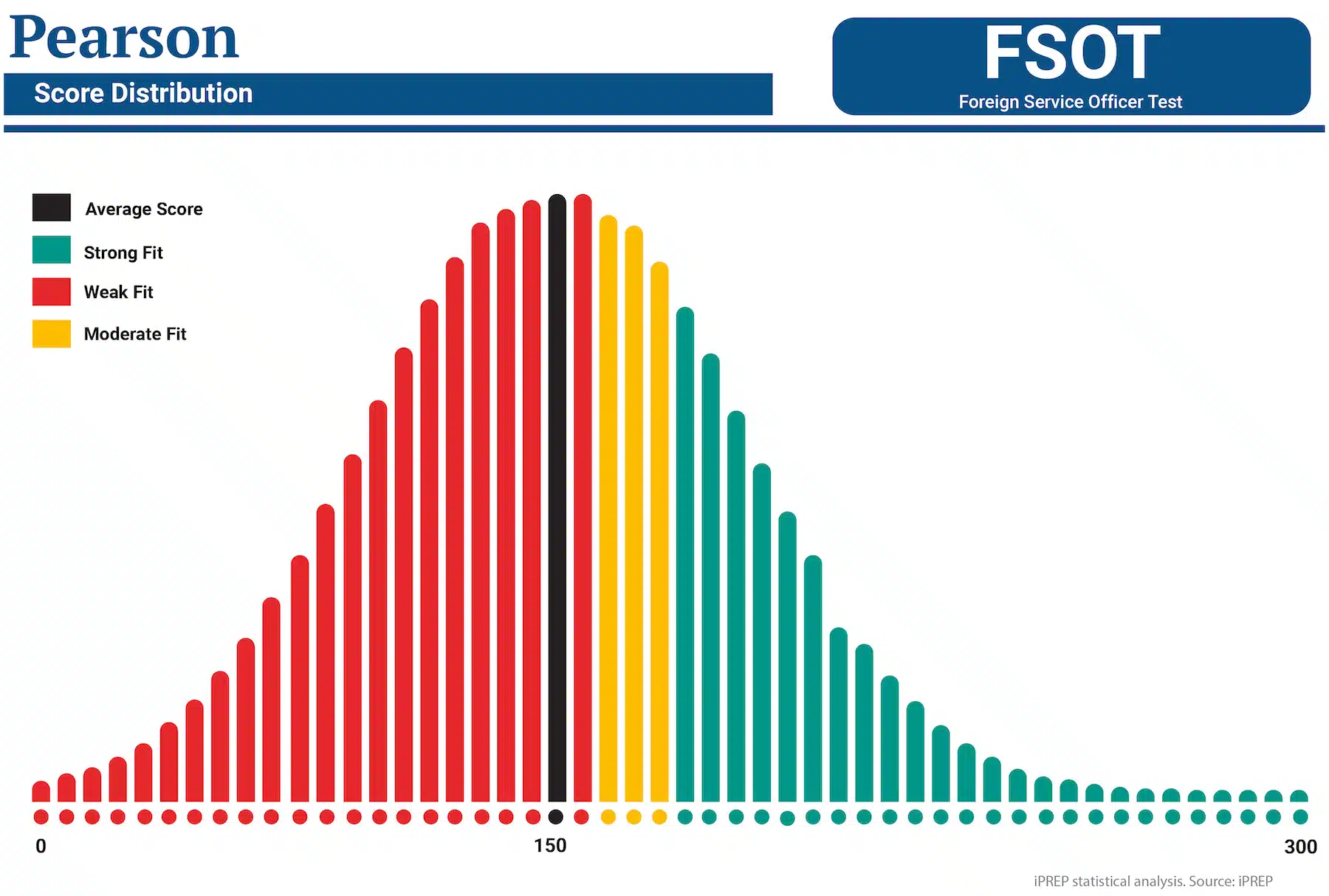
Well done!
You have completed the Sample Questions section.
The complete iPREP course includes full test simulations with detailed explanations and study guides.
‘…TESTS THAT ACTUALLY HELP’

In the first 30 minutes of use I have learned so much more than skipping along the internet looking for free content. Don’t waste you time, pay and get tests that actually help.
Richard Rodgers
January 28, 2020 at 7:49 PM
About the course
Welcome to iPrep’s FSOT (Foreign Service Officer Test) preparation course.
This course will help you boost your skills and with it your confidence towards your upcoming FSOT exam. This is the screening test for people looking for a career in the US foreign service. The course will provide you with the following tools and benefits:
- You will become familiar with the test’s various types of questions.
- You will be given full-length FSOT-style simulation tests. The simulations are divided into three sections: Job Knowledge, Situational Judgment, and English Expression.
- Each section includes similar questions to those you will encounter in the real test with the same level of difficulty. They also have the same time limit as the real test. Experiencing the test’s time pressure will ensure it will not come as a surprise on test day.
- You will be provided with a great variety of helpful tips for the different types of questions. Some of the tips are in the introductory sections while most are in the detailed explanations that follow each question.
25
Learning hours
2
Practice tests
620
Questions
320
Flashcards
By the end of this course, you will be more knowledgeable and comfortable with the FSOT test – Knowledge and familiarity with the test are the two most significant factors that can help you maximize your score and improve your chances of success.
The course is comprised of both practice and learning sessions. We will guide you through learning lessons with essential information about your upcoming test. These lessons will help you understand the underlying techniques that are essential for succeeding on the test.
The course is then concluded by its core component – simulating full-length tests that accurately follow the structure and concepts of the FSOT Exam. Once done, you will be able to get full question explanations and even see how well you performed in comparison with other people who have taken the test.
Skills you will learn
Job Knowledge
Situational Judgment
English Expression
Essay Writing
Curriculum
- Course Introduction
- Question Types Introduction
- Job Knowledge
- Situational Judgment
- English Expression
- Essay Writing
- Full-Length Test Simulations
- Bonus – Personal Narratives (PN) Guide
- Course Conclusion
Customer testimonial

I’ve been studying for the FSOT for a few months now. I’ve had a positive experience for the most part, but it has been so much better with iPrep. All the resources, information, and (most importantly) the practice that you need is in one place. iPrep is great preparation for the real deal. Thanks!
Michael Hollingsworth
August 24, 2023 at 8:30 PM
Reviews

Jose D***
January 30, 2025 at 5:02 PM
A great and easy-to-use platform that provides invaluable feedback after each practice session, helping users improve and refine their skills efficiently.

Baraa A******
September 27, 2024 at 10:43 AM
Great product, very easy to learn, has all the needed sources, it really helped me study for the test, and I feel I am ready now.

Laura L*****
September 19, 2024 at 7:51 PM
I haven't taken the exam yet, but the iPrep course has been fantastic. The content is well-structured, engaging, and easy to follow. The course materials are comprehensive and help to break down complex concepts into manageable pieces. The practice questions are especially helpful, allowing me to feel more confident and prepared for the exam. I highly recommend iPrep to anyone looking for an effective way to study and prepare!

Ally L**
September 16, 2024 at 3:05 PM
It is super helpful and I am glad I chose Iprep. I love the flashcard style and it helps me to remember the content and test myself.

Jean D***
July 24, 2024 at 5:00 AM
Great work here!! Best explanation using context clue. Very informative. Good for getting a good idea of what to expect in the test!!

Henry M*
June 8, 2024 at 7:10 AM
the test is very good and the answers are great with detail explanation. It really gives me a lot of confidence in taking this test.

Kathy H******
June 7, 2024 at 2:49 AM
I tried the two-day trial and enjoyed the course. The questions are similar to the fsot practice test that the state department gives, so you know you are getting quality testing questions. While the huge amount of testing questions is incredibly useful, I found the flashcards to be the most helpful especially when I felt too tired. Overall, really good overview and quality practice questions.

Osha B*******
May 31, 2024 at 2:02 PM
I learned so much in the first lesson I had to go back and rewrite my study outline. This course gets you excited to take the test and show what you have learned!

John L*****
May 27, 2024 at 7:40 PM
I was really nervous before I took the test, but working through the various problems every day gave me the confidence and skills needed to pass the test!

Lysander S*****
May 27, 2024 at 1:03 PM
This course was very helpful in preparing me for my test. Using it in the weeks leading up to my test date helped me feel prepared and confident going into the test.
